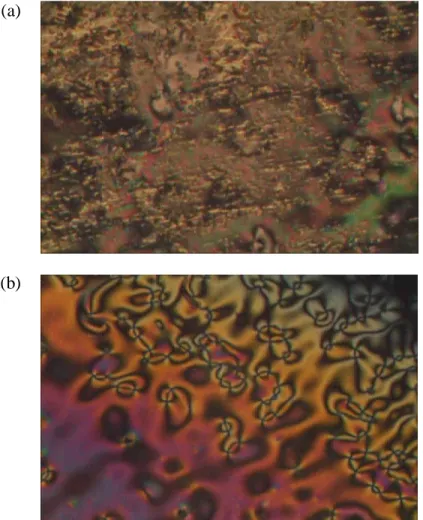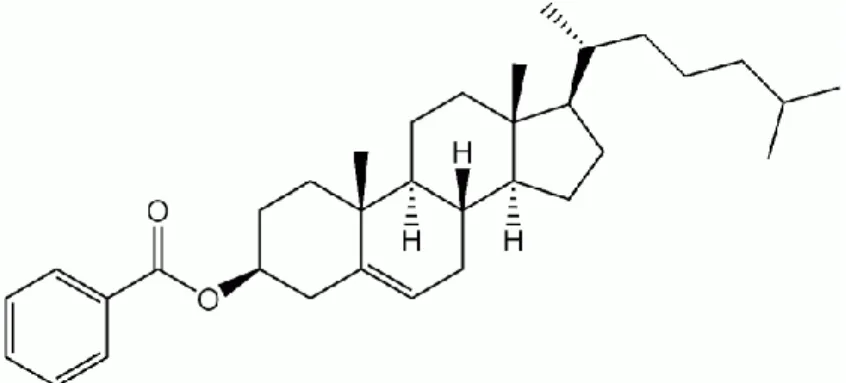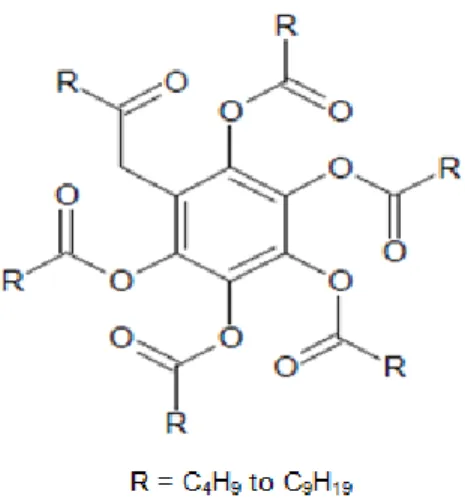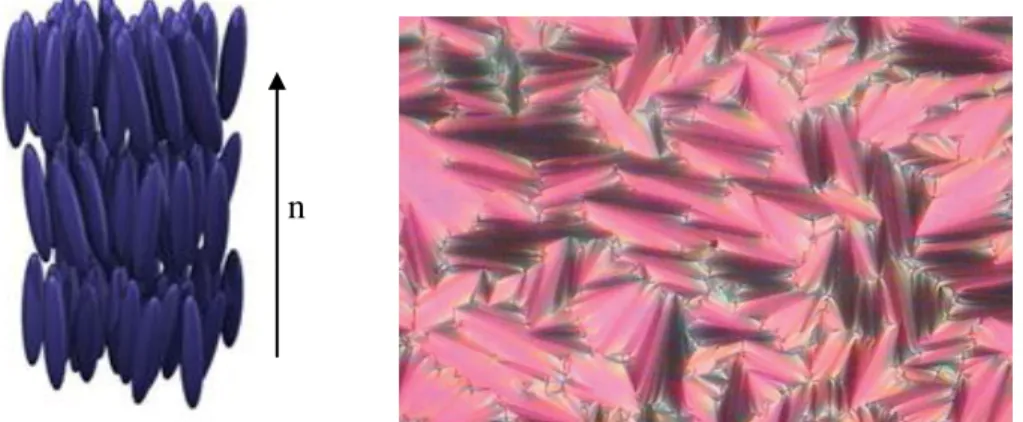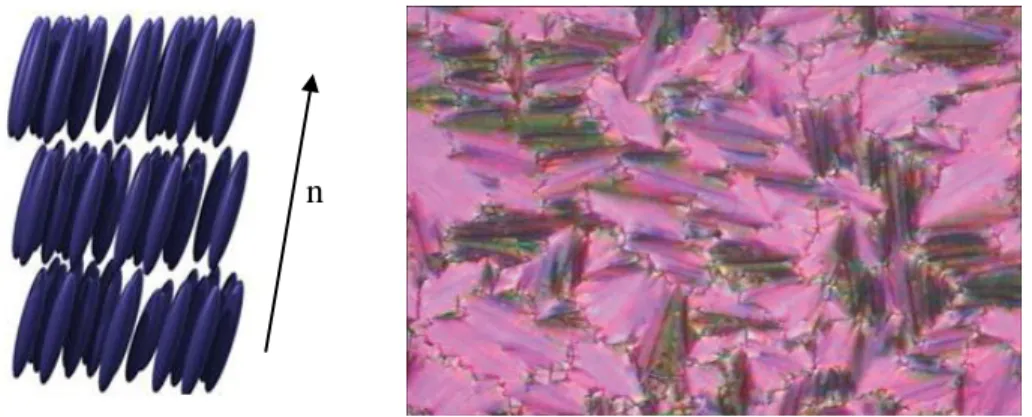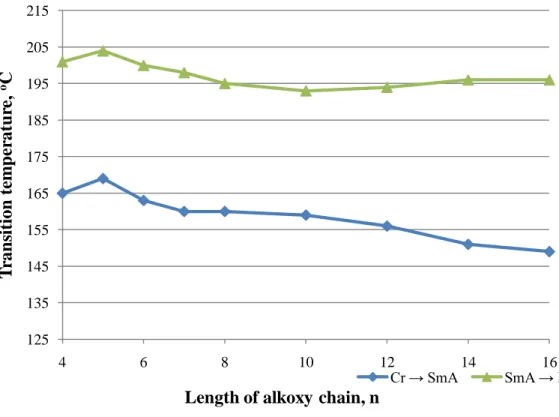A series of Schiff base esters, 4-(dimethylamino)benzylidene-4'-alkanoyloxyanilines (nDMABAA) containing different alkanoyloxy chain lengths (Cn-1H2n-1COO-, n at the end of the molecules) have been successfully synthesized. I confirm that, this project report entitled "SYNTHESIS AND CHARACTERIZATION OF SMECTIC AND NEMATIC PHASES IN 4-(DIMETHYLAMINO)BENZYLIDENE-4'-ALKANOYLOXYANILINES was prepared by GAN YEN SHING and submitted in partial fulfillment of the requirements for the degree of Bachelor of Science (Hons.) in Chemistry at the Universiti Tunku Abdul Rahman This is to confirm that GAN YEN SHING (ID No: 08ANB05471) has completed this report entitled "SYNTHESIS AND CHARACTERIZATION OF SMECTIC AND NEMATIC PHASES IN 4-(DIMETHYLAMINO)-BENZYLIDENE-4'-ALKANOYLOXYANILINES" under led by dr.
6DMABAA 4- (dimetielamino) Benzylideen-4'-heksanoyloxyaniline 8DMABAA 4- (dimetylamino) Benzylidene-4'-octanoyloyloxyaniline 10dmabaa 4- (dimethylamino) Benzylideen-4'-decanoyloxyaniline 12DMabaaaa ( -Dodecanoyloxyaniline 14DMABAA 4 -(Dimetielamino)bensielideen-4'-tetradekanoyloksianilien 16DMABAA 4-(Dimetielamino)benzylideen-4'-heksadekanoyloksisanilien 18DMABAA 4-(Dimetielamino)benzielideen-4'-oktadekanoyloksisanilien DMABAP 4-{()}fënielideen)amino.
Definition of Liquid Crystals
If the positional order either completely or partially disappears while some orientational order is maintained, the resulting phase will be a "liquid crystal". The fact that most of the order of a crystal is lost when it is converted to liquid crystal is revealed by the value of the latent heat. However, when a liquid crystal transforms to a liquid, the latent heat is much smaller, usually around 5 J/g.
Yet the small amount of order in a liquid crystal reveals itself through mechanical and electromagnetic properties typical of a crystal (Singh and Dunmur, 2002a).
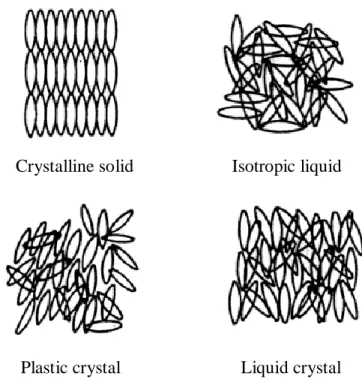
History of Liquid Crystals
Thermotropic Liquid Crystals
- Calamitic (Rod-Like) Liquid Crystals
But sometimes it is only possible to obtain a mesophase by cooling the isotropic liquid, such a mesophase is said to be monotropic. 6 Thermotropic liquid crystals can be further distinguished with respect to the molecular shape of the constituent molecules, called calamitic for rod-like and discotic for disc-like molecules. Calamitic liquid crystals or also known as rod-like liquid crystals are mesogens or mesogenic compounds with an elongated shape where one molecular axis is much longer than the other two.
Discotic liquid crystals or disk liquid crystals are mesogens or mesogenic compounds with a disk shape where one molecular axis is much shorter than the other two.
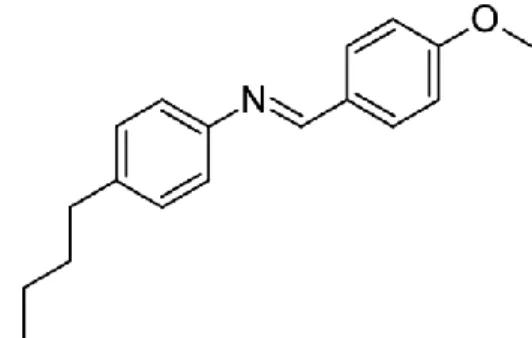
Lyotropic Liquid Crystals
As can be seen from Figure 1.5, the soap molecule has a polar "head" group attached to a hydrocarbon "tail" group. When dissolved in a polar solvent such as water, the hydrophobic “tails” will cluster together while the hydrophilic “heads” extend outward toward the solution to form a micellar structure as shown in Figure 1.6. 9 these micelles will eventually become ordered in solution as the concentration continues to increase (Fisch, 2006).
At certain concentrations, a lamellar phase (pure soap phase) is formed, where extended sheets of amphiphiles are separated by thin layers of water (Luzzati et al., 1957).
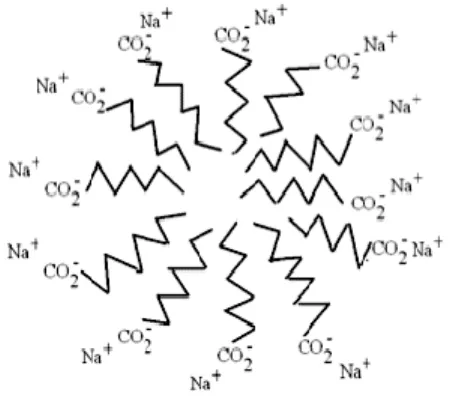
Phase Structures and Textures of Achiral Calamitic Liquid Crystals
Nematic Phase
Most nematics are uniaxial, meaning they contain one axis that is longer and preferred, with the other two being equivalent. However, some of them are biaxial nematics, meaning that they also orient along a secondary axis in addition to orienting their long axis (Madsen et al., 2004). Nematics have fluidity similar to that of isotropic fluids, but they can be easily aligned by an external magnetic or electric field.
Aligned nematics have the optical properties of uniaxial crystals, making them extremely useful in liquid crystal displays (Stegemeyer, 1994b).
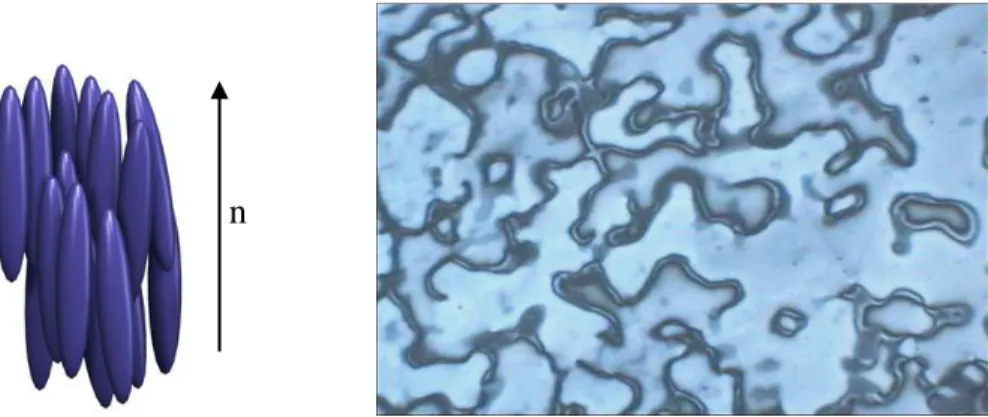
Smectic Phase
Structure of Calamitic Liquid Crystals
13 the structure and their combinations determine the type of liquid crystal phase and the physical properties that a compound exhibits (Stegemeyer, 1994a). The names of liquid crystals are often modeled after the linking group (eg Schiff-based liquid crystal). Usually, the rigid core alone is not sufficient to generate liquid crystal phases, and some flexibility is required to ensure a reasonably low melting point and to stabilize the molecular alignment in the mesophase structure.
Although generally detrimental to the formation of liquid crystal phases, many different types of side substituents (eg, F, Cl, CN, CH3) are often necessary to tailor their physical properties.
Objectives of Study
14 terminal chains are branched and the branching unit can be non-polar (e.g. CH3) or polar (e.g. CN, F, CF3); this design feature is normally used to introduce chirality into the molecules.
Schiff Base Liquid Crystals
Influence of Terminal Group on Mesomorphic Properties
Yet, the n-octyloxy to n-tetradecyloxy derivatives are still able to exhibit smectic A phase despite the presence of an isopropyl terminal group. It is known that branching in the alkyl chain adjacent to the phenyl ring drastically influences the mesomorphic properties of the system. As the end chain length increased, it provides more flexibility to the rigid core structure, favoring the monotropic smectic phase of SmA and SmB in C4 and C6.
The melting temperature decreased as the chain length increased up to C7 member, with the exception of C6 member. This happened due to the increase in the flexibility of the molecule induced by the longer alkyl chain. 20 The zig-zag pattern or the odd-even effect was observed in the melting temperatures of the lower members of the homologous series (C4, C5, C6, C7 and C8) as illustrated in Figure 2.3.
Such a trend of melting temperatures has been observed in several homologous liquid crystal systems (Demus et al., 1998). Similar changes in mesomorphic properties under the influence of alkyl chains can also be observed in the homologous series with 6-nitrobenzothiazole group at the end of the molecule, 2-(4'-n-alkoxyphenylazo)-6-nitrobenzothiazoles, nAPNB (Figure 2.4) reported by Prajapati and Bonde (2009). The reduction in SmA-I transition temperatures is due to the partial interpenetration of the layers, which occurs more readily as the terminal intermolecular attractions become weaker as the alkyl chains elongate.
Such phenomenon can be clearly observed in the study done by Thaker et al. 2007) on twelve homologues from each of the two series, 2[(4-n-Alkoxy-benzyloxy)phenyl azomethine]-5-methylthiazole (series A) and 2-[(4-n-Alkoxy-benzyloxy)-2-hydroxy salicylamine]-5-methyl thiazole (series B). Third, the strength of intermolecular lateral attractions decreased when long narrow molecules were forced further apart by increasing molecular width (Demus et al., 1998).

B and C (Belmar et al., 1999)
- Chemicals
- Synthesis of 4-(Dimethylamino)benzylidene-4’-alkanoyloxyanilines, nDMABAA
- Thin Layer Chromatography (TLC)
- Infrared Spectroscopy Analysis
- Mass Spectrometry Analysis
- Differential Scanning Calorimetry (DSC) Analysis
- Synthesis and Characterization of 4-{(4-(Dimethylamino)benzylidene) amino}phenol, DMABAP
- Synthesis Route of 4-{(4-(Dimethylamino)benzylidene)amino}phenol, DMABAP
The same procedures for synthesizing 6DMABAA were repeated, except that hexanoic acid was replaced by octanoic acid (0.14 g, 1 mmol). The same procedures for synthesizing 6DMABAA were repeated, except that hexanoic acid was replaced by decanoic acid (0.17 g, 1 mmol). The same procedures for synthesizing 6DMABAA were repeated, except that hexanoic acid was replaced by dodecanoic acid (0.20 g, 1 mmol).
The same procedures in synthesizing 6DMABAA were repeated except that hexanoic acid was replaced by tetradecanoic acid (0.23 g, 1 mmol). The same procedures in synthesizing 6DMABAA were repeated except that hexanoic acid was replaced by hexadecanoic acid (0.26 g, 1 mmol). The same procedures in synthesizing 6DMABAA were repeated except that hexanoic acid was replaced by octadecanoic acid (0.28 g, 1 mmol).
The appropriate amount of sample was dissolved in chloroform and a small spot of the resulting solution was applied to the surface of an aluminum-supported silica gel plate (Merck 60 F254), approximately 1.5 cm from the bottom edge. First, a small amount of sample and potassium bromide at a ratio of 1:10 were thoroughly ground in a mortar. The sample-potassium bromide mixture was then transferred into the cylinder bore with the smooth surface of the lower pellet facing it.
As illustrated in Figure 4.2, mechanism of Schiff base formation for DMABAP is divided into two parts: acid-catalyzed nucleophilic addition of amine to the carbonyl group (part I) and acid-catalyzed dehydration of carbinolamine (part II). In part I, the mechanism begins with the H+ ion of acetic acid forming a bond with the carbonyl oxygen atom, giving it a positive charge.
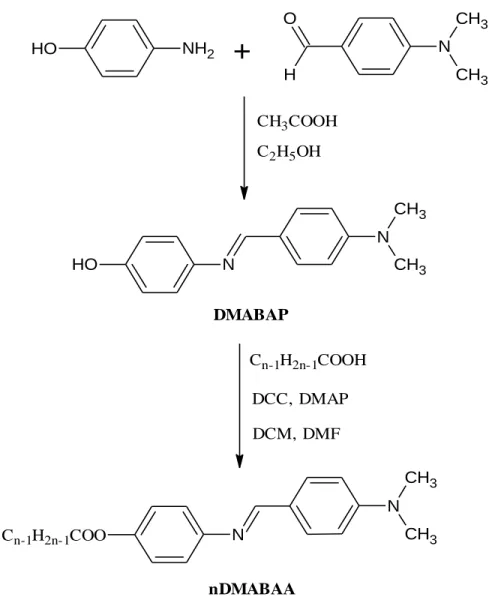
Acid-catalyzed nucleophilic addition of amine to the carbonyl group
Acid-catalyzed dehydration of carbinolamine
Synthesis Route of 4-(Dimethylamino)benzylidene-4’-alkanoyloxy aniline, nDMABAA
Steglich esterification took place between the Schiff base intermediate, DMABAP and fatty acids with different number of carbon atoms (Cn-1H2n-1COOH, n with DCC as coupling reagent, DMAP as catalyst and DCM, DMF as solvents to form the ester compounds, nDMABAA . The mechanism is divided into two parts: formation of O-acylisourea intermediate (part I) and formation of DHU and the corresponding ester (part II). In part I, DCC first forms a bond to the hydrogen atom of fatty acid using of the lone pair of electrons on its nitrogen atom, giving the oxygen atom a negative charge and the nitrogen atom a positive charge.
The negatively charged oxygen atom then attacks the carbon atom of DCC, breaking the π-bond and eliminating the positive charge on the nitrogen atom to form the O-acylisourea intermediate, which offers reactivity similar to the corresponding fatty anhydride. In Part II, the mechanism starts with the H+ ion forming a bond with the lone pair of electrons on the nitrogen atom, giving the nitrogen atom a positive charge. DMABAP then attacks the carbonyl carbon atom with the lone pair of electrons on its oxygen atom, breaking the C-O bond.
Electrons from breaking the C-O bond are transferred to eliminate the positive charge on the nitrogen atom, forming the unwanted byproduct DHU. Finally, the corresponding ester is formed by losing an H + ion, which also helps balance the ions by replacing the used H + ion (Neises and Steglich 1978).
Formation of DHU and the corresponding ester
- Polarising Optical Microscopy Analysis of nDMABAA
Lower derivatives (n = 6, 8 and 10) exhibited only nematic phase, medium derivatives (n = 12) exhibited coexistence of both nematic and smectic phases and higher derivatives (n = 14, 16 and 18) exhibited only smectic A-phase display. In addition to this, Brownian flashes (Figure 4.18b), a feature of the nematic phase, were also observed before recrystallization. The relatively small peak at 94.0 oC (2.69 kJ mol-1) represents the phase transition from isotropic to smectic A phase.
As observed in the cooling cycle of 14DMABAA, the enthalpy changes of phase transition from isotopic to smectic A phase (2.69 kJ mol-1) are much smaller than that from smectic A to crystal phase (34.60 kJ mol-1). Considering the chemical composition of the nDMABAA series, the appearance of nematic phase at the lower derivatives could be due to the branched methyl group terminal, which disrupted the lamellar packing of smectic phase. As the length of the alkyl chain increased, coexistence of nematic and smectic A phase was observed for the C12 derivative.
This suggests that the increase in alkyl chain length causes the nematic properties to decrease, which in turn leads to enhancement of the smectic properties. This is because the attractive forces between the long alkyl chains lead to their entanglement, facilitating the lamellar packing necessary for the generation of the smectic phase (Collings and Hird, 1998b). Therefore, it can be proposed that to generate smectic phase in the analogous sequence, there must be at least four carbon atoms in the alkyl chain.
The lowest derivatives (n = 6, 8 and 10) showed only the nematic phase, the middle derivatives (n = 12) showed coexistence of both nematic and smectic A phases and the highest derivatives (n = 14, 16 and 18) showed only smectic A phase. As the length of the alkyl chain increases, the tendency for the smectic phase to emerge increases and eventually eliminates the nematic phase. This is due to the attractive forces between the long alkyl chains leading to their entanglement, which facilitates the lamellar packing required for the generation of the smectic phase.
DSC further confirmed the presence of phase transitions of the compounds observed during POM by detecting the enthalpy changes associated with each phase transition.
